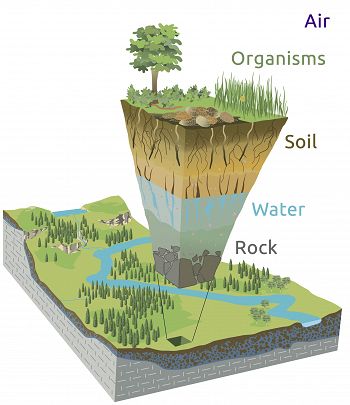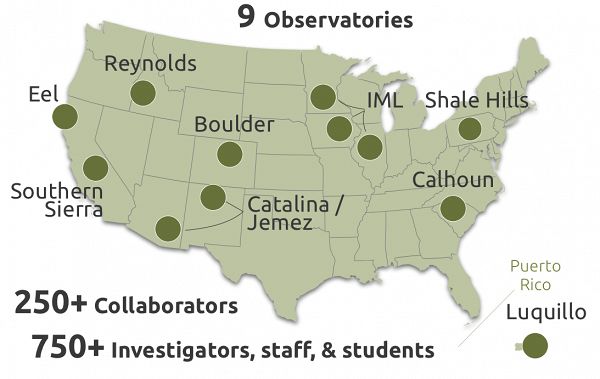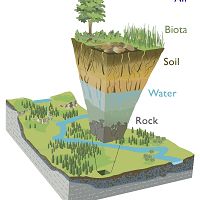Highlights of CZO data resources and activities
Data highlights
For AGU 2018, we've assembled a two-page document with examples of CZO data activities.
- Data handout (3 MB PDF)
On this page:
DATA RESOURCES - HIGHLIGHTS
CZ science uses integrated, diverse data
Critical Zone scientists need integrated data to inform our theoretical frameworks, constrain our conceptual and numerical models, and test our hypotheses -- both within a CZO and across the CZO network.
- Highly interdisciplinary data.
- Very wide range of timescales.
- Many data types (sensors & samples).
Current data access
Start at CriticalZone.org
- Access data produced by CZO.
- Access CZ data produced by USGS, NOAA, USDA, NEON, LTER and other partners.
- criticalzone.org/national/data/
Search our centralized metadata catalog
- 400+ datasets.
- 2000+ URLs pointing to files & webpages.
- Millions of data values.
-
criticalzone.org/national/data/datasets/
Browse 70+ main topics including Meteorology, Soil Moisture, GIS/MapData, Streamflow/Discharge, Precipitation, Soil Temperature, LiDAR, Stream Water Chemistry, and many more.
Access additional resources
- Data catalogs at individual observatories.
- Domain-specific, long-term repositories (i.e. LiDAR at OpenTopography.org).
Network data products
Assembling cross-CZO datasets
In the past few years, CZO data managers have been synthesizing more of CZO’s common measurements into cross-network data products. Some products are complete and available on CriticalZone.org via the national/data webpage. Transfer of some of the datasets to CUAHSI's HydroShare repository is underway.
Example cross-CZO datasets
- Stream Water Chemistry - Cations, Anions, Metals (1982-2015)
- Climate, Flux Tower, Streamflow / Discharge - CUAHSI WDC web services (1968-2015)
- Soil Gas - CO2 and O2 (2014-2017)
- LiDAR, Land Cover, GIS/Map Data - OpenTopography (2010-2017)
- Air Temperature, Flux Tower, Meteorology - NADP and NOAA or other weather stations (2017)
- Flux Tower - AmeriFlux Network data (2007-2018)
- Streamflow / Discharge - USGS and USDA Data Resources (1985-2017)
Tool development
Data management software
With our partners, CZO has contributed to a series of software projects that help structure and manage our diverse data. They include:
- ODM2 - Robust data model for Critical Zone science.
- ODM2 Admin - Management of sensor and sample-based data collected from a field site.
- Clowder - Customized data catalogs in the cloud to help manage research data for groups and communities.
- Dendra - Interface for sensor database, University of California’s SensorBase.
HYDROSHARE DATA MIGRATION - HIGHLIGHTS
Improved data discovery across the CZO network, in one location
CUAHSI HydroShare enables groups and individuals to share data and models: storage, analysis, and publication
CZO is partnering with CUAHSI to migrate our data catalog from CriticalZone.org to CUAHSI’s HydroShare.org repository later in 2019
Partnering will provide a more sustainable data management solution for the CZO community. Improvements to HydroShare made on behalf of CZO will benefit the entire HydroShare user community.
Central, long-term repository
Migrated data will have improved long-term viability and enhanced discoverability.
- Our current storage is limited to individual CZOs and domain-specific repositories like OpenTopography.org.
- Migration is especially important for data at risk of becoming inaccessible (i.e. grad student research).
- Completed data resources can be issued DOIs.
- Using HydroShare infrastructure will reduce our dependence on hardware and software at all CZOs.
Note: Not all CZO data can be migrated to HydroShare in 2019. Although we will migrate all the metadata, transferring all data is too large of a project for the short term. We will start with easily accessible flat files.
Improved search & browse
We gain a metadata catalog with more functionality.
- Current system has limited functionality derived from a standard Content Management System (CMS).
- HydroShare is optimized for science metadata, i.e., automatic extraction of metadata from some file types.
More controlled vocabulary (CV) terms than before.
- Yields better search results, improved data interoperability among CZOs and with outside organizations.
- More standardization of terms, especially for variables. For example, instead of a half dozen ways to denote dissolved calcium, there will be one.
- Initial work condensed ~1900 variable names down to 340 standard terms (within ODM2 information model).
Enhanced collaboration
CZO researchers can work together more easily and share more widely.
- Work privately with others on preliminary data. When ready, make data discoverable and/or downloadable.
- Explore data with others via the JupyterHub app, including online analysis & modelling.
- Share all products of a study, including primary data, supporting data, workflows, and models.
- Connect to the robust HydroShare API for data access and reuse by individuals and applications.
HydroShare + Clowder
CZO and CUAHSI are collaborating with the Clowder team (led by NCSA), with emphasis on authoring metadata and interoperability between HydroShare and Clowder.
- Clowder is online software that helps communities manage research data via customized data catalogs and data processing tools.
- Clowder has strengths in incrementally adding data and metadata, data visualization, & other custom functionality.
- HydroShare has strengths in long-term data archival, publication, discovery, and connections to models via apps.
After Chorover et al, 2007. Catalina-Jemez CZO
Locations of our nine Critical Zone Observatories
CUAHSI HydroShare enables groups and individuals to share data and models: storage, analysis, and publication
Migration of CZO data catalog to HydroShare
News Category:
DATA
Explore Further






